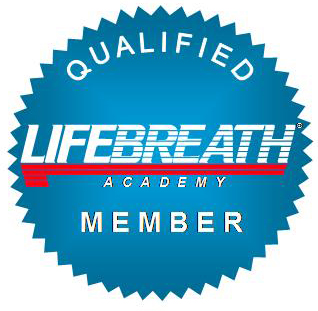Prevention is better than cure … how to approach the risk of Radon?
.
The hormesis applied to the Radon risk.
Radon is not a risk in itself, being a weakly radioactive and inert gas (as it is inhaled is exhaled), but becomes a significant contributing cause of the development of lung tumors through its “daughters” (i.e. its decay products: Polonium-218, Bismuth-214, Lead-214), as these are highly reactive and radioactive dust, first attach themselves to thin environmental dusts and then in the mucous membranes of the respiratory system.
Considering the hormetic phenomenon, which represents positive responses to low and very low doses (see article below : “The state of research on hormetic phenomena: the effects of low Radon doses”), we can list the preventive measures required to manage safely the potential risks posed by Radon, then passing from the calculation of a LLE – Loss of Life Expectancy to a GLE – Gain of Life Expectancy:
a) ventilate to reduce the concentration of Radon in air, b) filter the air of fine particles (eg PM10 and smoking) to which the decay products of Radon are fixed, c) undergo to a preventive low-dose radiotherapy, such as the “low-dose helical CT screening“. ..
In order to aerate and filter, we need a constant and controlled ventilation with energy recovery (ERV / HRV – Energy / Heat Recovery Ventilation), equipped with an HEPA – High Efficiency Particulate Air filter.
.
The state of research on hormetic phenomena: the effects of low Radon doses
Apparently, the extended development of non-linear theories and laws has not affected the legislative inaction on the “Risk Assessment” in toxicology and radioprotection, where it reigns supreme a linear view of the phenomena and a distorted application of the Precautionary Principle, of which the notorious law LNT (Linear No Threshold) is the emblematic fruit.
It’s worth recalling what the non-linear visions are antiques, just let’s mention Paracelsus (XVI century) “All substances are toxic, only the dose makes the difference between a poison and a medicine.”
Fortunately, the linear approaches have not fully prevented the development of radiotherapy and drug therapies based on the biphasic responses (hormesis), which in hindsight provide valuable experimental confirmation to the validity of the hormetic phenomena, waiting for the scientific world asserts again with pride and consistency of not being subject to socio-political arguments, but only to the scientific method.
In line with this pragmatic scientific approach we should be able to achieve a correct evaluation of the effects of low-dose of Radon.
The inhalation of Radon, and in general the quality of the air breathed indoors, is a topic of particular interest from the health point of view (SBS – Sick Building Syndrome) and by its nature has a relevance that can influence the current settings in the hope that “the consolidation of the knowledge base of hormesis will bring profound changes in many sciences, a revolution dose-response, which, like a tidal wave, change perceptions, principles and activities of toxicological and ecotoxicological (Ormesi: la rivoluzione dose-risposta, Luciana Migliore – Università di Tor Vergata, Roma).
.
The concept
“All substances are toxic, only the dose makes the difference between a poison and a medicine.” Paracelsus (XVI century)
.The definition – the hormesis, a biphasic phenomenon
“The hormesis can be regarded as an adaptive function characterized by a dose-dependent biphasic response, which occurs as a result of exposure to a very wide range of stimuli,” Calabrese and Baldwin, 2002
The hormetic responses generally show a slight stimulation at low doses (> 30-60% of control) and inhibition at high doses. In order the “qualitative” definition of the hormesis could be satisfied , must necessarily be present both stimulatory and inhibitory size.
The hormetic response curve can be represented by a parabola, a straight or inverted U in relation to the endpoint in question:
U straight – if you measure damage, such as increased mortality, alteration of some physiological function or occurrence of diseases (like cancer or cardiovascular disease); U-turn – if you measure physiological functions such as growth or survival. .The hormetic response can be induced directly (DSH, Direct Stimulation Hormesis), or be the result of compensatory biological processes, resulting from an initial disorder in the homeostasis (OCSH, Over Compensation Stimulation Hormesis).
.The consequences – the linear view mainly produces three serious consequences
The overcome of the LNT (Linear No Threshold Theory) and the introduction of the hormetic phenomenon involves fundamental changes to the ecotoxicology as well as for the ‘Ecological Risk Assessment (ERA), but also represents a new era for the development of new curative and preventive therapies.
Reading the graphs, reported below, you can “feel” better the impact of a renewed scientific view, as opposed to the simplified linear approche and the distorted application of the precautionary principle. At center the natural phenomenon with it biphasic curve (hormesis) that shows a decrease in the response (eg. tumors), compared to zero dose, for low levels. At the right and left, the graphs show the two linear simplifications, the first called LNT (Linear No Threshold Theory) suggests an increased response at low and very low doses, the second recognizes a zone of “no evidence of significant effects” until a certain threshold.
The linear view mainly produces three major consequences:
1) inhibits the development of treatment protocols with low and very low doses, particularly for disease prevention, with grave consequences for the populations health and the rising costs of healthcare for interventions ex post. 2) leads to an underestimation of the response to significant doses, with the risk of overdoses in the treatment and underestimation of the damage caused by the most significant pollutants. 3) leads to describe non-existent risk at low-doses, such as in Ecological Risk Assessment, with the risk of a ban of whole areas of sciences, wich are important for economic development. .Therapeutic application of the hormetic phenomenon
Not surprisingly, a new and interesting application of the hormetic phenomenon comes from american radiotherapists who have decided, through an interesting approach, to combine a screenning with a preventive therapy at low-doses on a population at high risk of lung cancer ; the “heavy” smokers aged between 55 and 74 years, provides us a useful result for a correct approach to the risk posed by Radon.
Here below an extract of the article published on the National Cancer Institute (NCI) website, which documents a 20% reduction in deaths due to lung cancer and 7% of deaths attributable to all cancers (including lung cancer). The search lasted 8 years and has involved a significant sample (53,000 patients) and representative of the population at risk of lung cancer.
Lung Cancer Screening Using Helical CT vs. Chest X-ray, Reduces Deaths among Current and Former Heavy Smokers NOVEMBER 4, 2010, 11:00AM, By Brooke Layne Hardison http://benchmarks.cancer.gov/2010/11/lung-cancer-screening-using-helical-ct-vs-chest-x-ray-reduces-deaths-among-current-and-former-heavy-smokers/ .People with a history of smoking have a high risk of lung cancer – a disease with a five-year relative survival rate (for smokers and nonsmokers combined) of only 15.8 percent. Previous attempts at developing a test to find lung cancer early, when it is easier to treat, have not been able to demonstrate a decrease in mortality rates. Now, a study sponsored by the National Cancer Institute (NCI) has determined that low-dose helical computed tomography (CT) scans can reduce lung cancer mortality for current and former heavy smokers. In the nation-wide study, which included over 53,000 participants, researchers found 20 percent fewer lung cancer deaths among those who were screened with low-dose helical CT (also known as spiral CT) compared with those who were screened with chest X-rays. In addition, deaths from all-causes (including lung cancer) were seven percent lower in those who received the low-dose helical CT scans. .
“This is the first time that we have seen clear evidence of a significant reduction in mortality with a lung screening test in a randomized controlled trial. The fact that low-dose helical CT provides a decided benefit will be a result that will have implications for the screening and management of lung cancer for many years to come,” said Christine Berg, M.D., NLST project officer for the NCI. “The results of this trial provide objective evidence of the benefits of low-dose helical CT screening in an older, high-risk population and suggest that if low-dose helical CT screening is implemented responsibly, and individuals with abnormalities are judiciously followed, we have the potential to save thousands of lives,” said Denise Aberle, M.D., NLST national principal investigator for ACRIN.
.
The hormesis applied to the Radon risk
Radon is not a risk in itself, being a weakly radioactive and inert gas (as it is inhaled is exhaled), but becomes a significant contributing cause of the development of lung tumors through its “daughters” (i.e. its decay products: Polonium -218, Bismuth-214, Lead-214), as these are highly reactive and radioactive dust, first attach themselves to thin environmental dusts and then in the mucous membranes of the respiratory system.
Considering the hormetic phenomenon, which represents positive responses to low and very low doses (see article below : “The state of research on hormetic phenomena: the effects of low Radon doses”), we can list the preventive measures required to manage safely the potential risks posed by Radon, then passing from the calculation of a LLE – Loss of Life Expectancy to a GLE – Gain of Life Expectancy:
a) ventilate to reduce the concentration of Radon in air, b) filter the air of fine particles (eg PM10 and smoking) to which the decay products of Radon are fixed, c) undergo to a preventive low-dose radiotherapy, such as the “low-dose helical CT screening.” .In order to aerate and filter, we need a constant and controlled ventilation with energy recovery (ERV / HRV – Energy / Heat Recovery Ventilation), equipped with an HEPA – High Efficiency Particulate Air filter. .
Main bibliography:
1) Vivere con le radiazioni, di Giuseppe Filipponi. http://fusione.altervista.org/vivere_con_le_radiazioni.htm 2) Ormesi: la rivoluzione dose-risposta, di Antonella Amendola – APAT, Nadia L. Cerioli – APAT, Luciana Migliore – Università di Tor Vergata, Roma. APAT – Agenzia per la protezione dell’ambiente e per i servizi tecnici, www.apat.it, ISBN 88-448-194-9. http://www.apat.gov.it/site/_contentfiles/00143300/143331_miscellanea_2006_07.pdf 3) Lung Cancer Screening Using Helical CT vs. Chest X-ray, Reduces Deaths among Current and Former Heavy Smokers, di Brooke Layne Hardison. http://benchmarks.cancer.gov/2010/11/lung-cancer-screening-using-helical-ct-vs-chest-x-ray-reduces-deaths-among-current-and-former-heavy-smokers/









 KlimaHouse
KlimaHouse LifeBreath
LifeBreath Mitsubishi electric
Mitsubishi electric sanuvox
sanuvox Amatrice – Club Alpino Italiano
Amatrice – Club Alpino Italiano Amatrice – Comune
Amatrice – Comune Amatrice – Parco Nazionale
Amatrice – Parco Nazionale amatrice.net
amatrice.net amatriciana.org
amatriciana.org Excursions
Excursions News
News

Leave a Reply
You must be logged in to post a comment.